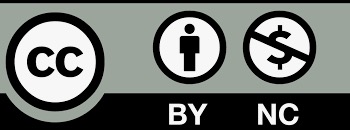Published
2024-01-09
Issue
Section
Research Articles
License
The journal adopts the Attribution-NonCommercial 4.0 International (CC BY-NC 4.0), which means that anyone can reuse and redistribute the materials for non-commercial purposes as long as you follow the license terms and the original source is properly cited.
Author(s) shall retain the copyright of their work and grant the Journal/Publisher rights for the first publication with the work concurrently licensed since 2023 Vol.8 No.2.
Under this license, author(s) will allow third parties to download, reuse, reprint, modify, distribute and/or copy the content under the condition that the authors are given credit. No permission is required from the authors or the publisher.
This broad license intends to facilitate free access, as well as the unrestricted use of original works of all types. This ensures that the published work is freely and openly available in perpetuity.
By providing open access, the following benefits are brought about:
- Higher Visibility, Availability and Citations-free and unlimited accessibility of the publication over the internet without any restrictions increases citation of the article.
- Ease of search-publications are easily searchable in search engines and indexing databases.
- Rapid Publication – accepted papers are immediately published online.
- Available for free download immediately after publication at https://esp.as-pub.com/index.php/ESP

Copyright Statement
1.The authors certify that the submitted manuscripts are original works, do not infringe the rights of others, are free from academic misconduct and confidentiality issues, and that there are no disputes over the authorship scheme of the collaborative articles. In case of infringement, academic misconduct and confidentiality issues, as well as disputes over the authorship scheme, all responsibilities will be borne by the authors.
2. The author agrees to grant the Editorial Office of Environment and Social Psychology a licence to use the reproduction right, distribution right, information network dissemination right, performance right, translation right, and compilation right of the submitted manuscript, including the work as a whole, as well as the diagrams, tables, abstracts, and any other parts that can be extracted from the work and used in accordance with the characteristics of the journal. The Editorial Board of Environment and Social Psychology has the right to use and sub-licence the above mentioned works for wide dissemination in print, electronic and online versions, and, in accordance with the characteristics of the periodical, for the period of legal protection of the property right of the copyright in the work, and for the territorial scope of the work throughout the world.
3. The authors are entitled to the copyright of their works under the relevant laws of Singapore, provided that they do not exercise their rights in a manner prejudicial to the interests of the Journal.
About Licence
Environment and Social Psychology is an open access journal and all published work is available under the Creative Commons Licence, Authors shall retain copyright of their work and grant the journal/publisher the right of first publication, and their work shall be licensed under the Attribution-NonCommercial 4.0 International (CC BY-NC 4.0).
Under this licence, the author grants permission to third parties to download, reuse, reprint, modify, distribute and/or copy the content with attribution to the author. No permission from the author or publisher is required.
This broad licence is intended to facilitate free access to and unrestricted use of original works of all kinds. This ensures that published works remain free and accessible in perpetuity. Submitted manuscripts, once accepted, are immediately available to the public and permanently accessible free of charge on the journal’s official website (https://esp.as-pub.com/index.php/ESP). Allowing users to read, download, copy, print, search for or link to the full text of the article, or use it for other legal purposes. However, the use of the work must retain the author's signature, be limited to non-commercial purposes, and not be interpretative.
Click to download <Agreement on the Licence for the Use of Copyright on Environmental and Social Psychology>.
How to Cite
The effect of social media on open innovation mediated by knowledge construction process (the case of study: Employees of Mashhad airline agencies)
Seyed Mohammad Hashem Hosseini
Department of Management, Attar Institute of Higher Education
Omid Behboodi
Department of Management, Attar Institute of Higher Education
DOI: https://doi.org/10.54517/esp.v9i4.1944
Keywords: social media use, open innovation culture, knowledge construction process, religious tourism
Abstract
Marketing in tourism industry has been done in different eras based on the media available to managers of this industry. With the emergence of new media, the type of marketing activity has also changed. Employees’ skills are also important and the success of the individual or the organization depends on committed and expert human resources. Therefore, the present research aimed to explore the mediating role of knowledge construction process in the relationship between social media and open innovation of employees of Mashhad airline agencies. The research population consisted of all employees of airline agencies in Mashhad. The sample size was estimated using a convenience sampling method. The final size was estimated at 348. The data collection instrument was a standard questionnaire used to check the validity of the construct using confirmatory factor analysis. Cronbach’s alpha coefficient and composite reliability were used to measure reliability. The results substantiated the validity and reliability of the questionnaire. The data analysis was used through a structural equation modeling in Smart PLS. The results showed that the use of social media affected open innovation and knowledge construction. The use of knowledge construction is effective in open innovation. The knowledge construction process mediates the relationship between social media and open innovation.
References
[1]. Dencik J, Fisher LG, Higgins L, et al. Factors that make open innovation more successful than traditional approaches. Strategy & Leadership. 2023, 51(5): 22-29. doi: 10.1108/sl-05-2023-0057
[2]. Xu C, Xu Y. Exploring the effects of director network on open innovation: the moderating role of CEO short-sightedness. European Journal of Innovation Management. 2023. doi: 10.1108/ejim-09-2022-0463
[3]. Bashir M, Pradhan S. The influence of knowledge-oriented leadership on business model innovation and open innovation: mediating role of absorptive capacity. Management Decision. 2023. doi: 10.1108/md-10-2022-1481
[4]. Jalilvand MR, Khazaei Pool J, Khodadadi M, Sharifi M. Information technology competency and knowledge management in the hospitality industry service supply chain. Tourism Review. 2019, 74(4): 872-884. doi: 10.1108/TR-04-2018-0054
[5]. Corral de Zubielqui G, Lindsay N, Lindsay W, Jones J. Knowledge quality, innovation and firm performance: a study of knowledge transfer in SMEs. Small Business Economics. 2019, 53: 145-164. doi: 10.1007/s11187-018-0046-0
[6]. Kumar J, Tapar AV, Bhattacharjee S. Social media and the bottom of the pyramid: a systematic literature review and future research agenda. International Journal of Emerging Markets. 2023. doi: 10.1108/ijoem-08-2022-1340
[7]. Hou JR, Kankham S. Follow and spread the word: the effects of avatars and message framing in promoting fact checking posts on social media. Information Technology & People. 2023. doi: 10.1108/itp-10-2022-0793
[8]. Keegan BJ, Rowley J. Evaluation and decision making in social media marketing. Management decision, 2017, 55(1), 15-31. doi: 10.1108/MD-10-2015-0450
[9]. Neeley TB, Leonardi PM. Enacting knowledge strategy through social media: P assable trust and the paradox of nonwork interactions. Strategic management journal. 2018, 39(3), 922-946. doi: 10.1002/smj.2739
[10]. Kaplan S, Tokgoz H. Objective and subjective evaluations of quilted mattress ticking fabrics for their thermal comfort performances. International Journal of Clothing Science and Technology. 2023, 35(4): 648-664. doi: 10.1108/ijcst-10-2022-0138
[11]. Schuhbert A, Thees H, Pechlaner H. Deep and organizational learning as innovation catalyzer in digital business ecosystems–a scenario analysis on the tourism destination Berlin. European Journal of Innovation Management. 2023. doi: 10.1108/EJIM-08-2022-0448
[12]. Wang G, Zhang L, Guo J. The impact of advanced manufacturing technology (AMT) application on product innovation performance: a model of mediated moderated effect. International Journal of Innovation Science. 2022, 15(3): 457-478. doi: 10.1108/ijis-06-2021-0108
[13]. Splitter V, Trittin H. Theorizing the ‘social’ in social media: The role of productive dialogs for collaborative knowledge creation. SocArXiv Papers. 2018.
[14]. Ghafourian Shagerdi A, Daneshmand B, Behboodi O. The impact of social networks marketing toward purchase intention and brand loyalty. New Marketing Research Journal. 2017, 7(3), 175-190. doi: 10.22108/nmrj.2018.89511.0
[15]. Mozaffari Vanani. The effect of brand community in social networks on customers’ trust and loyalty to the brand [Master’s thesis]. Allameh Tabatabai University; 2013.
[16]. Khatri D. Use of social media information sources: a systematic literature review. Online Information Review. 2021, 45(6), 1039-1063. doi: 10.1108/OIR-04-2020-0152
[17]. Hossain MdA. Effects of uses and gratifications on social media use. PSU Research Review. 2019, 3(1): 16-28. doi: 10.1108/prr-07-2018-0023
[18]. Ferris AL, Hollenbaugh EE, Sommer PA. Applying the Uses and Gratifications Model to Examine Consequences of Social Media Addiction. Social Media + Society. 2021, 7(2): 205630512110190. doi: 10.1177/20563051211019003
[19]. Drucker PF. The theory of the business. Alfred P. Sloan: Critical evaluations in business and management. 1994, 2, 258-282.
[20]. Chaubey A, Sahoo CK. The drivers of employee creativity and organizational innovation: a dynamic capability view. Benchmarking: An International Journal. 2022, 29(8): 2417-2449. doi: 10.1108/BIJ-06-2021-0316
[21]. Behboodi O, Ghayour Baghbani SM, Sheybak R. The Effect of Entrepreneurship orientation, Market orientation and Knowledge Management orientation on Sustainable Competitive Advantage, Investigating the mediating role of new product development. Journal of Coaching in Management & Productivity Development, 2022; 1(1): 59-71. doi: 10.22034/jcmpd.2022.546138.1007
[22]. Inkpen AC. Learning and knowledge acquisition through international strategic alliances. Academy of Management Perspectives. 1998, 12(4): 69-80. doi: 10.5465/ame.1998.1333953
[23]. Lyles MA, Salk JE. Knowledge acquisition from foreign parents in international joint ventures: An empirical examination in the Hungarian context. Journal of international business studies. 1996, 27, 877-903. doi: 10.1057/palgrave.jibs.8490155
[24]. COHEN, Wesley M, LEVINTHAL, Daniel A. Absorptive capacity: A new perspective on learning and innovation. Administrative science quarterly, 1990, 128-152. doi: 10.2307/2393553
[25]. Hofmann P, Stähle P, Buck C, Thorwarth H. Data-driven Applications to Foster Absorptive Capacity: A Literature-based Conceptualization. HICSS. (2021).
[26]. Arabshahi M, Kabiri A, Behboodi O. The Impact of Top Managers’ Knowledge Value on Knowledge Sharing Practices on Open Innovation and Organizational Performance. Scientific Journal of Strategic Management of Organizational Knowledge. 2022, 5(1), 165-191.
[27]. Rooh Bakhshan S, Derlik M. Investigating the effect of knowledge-based leadership on open innovation through the mediating role of absorptive capacity. majournal [Internet]. 2023; 6(20):1427-1440.
[28]. Babaee Farsani M, Hasanimoghadam S, Farhadi F. The interaction of Open Innovation with Absorptive Capacity, Leadership, and Organizational Learning Culture in Knowledge-Based Companies: Analyzing a moderated mediation model. Scientific Journal of Strategic Management of Organizational Knowledge. 2021, 4(1), 197-228.
[29]. Sadabadi AA, Mehraien F, Rahimi Rad Z. Social Networks at the Service of Social Innovation and Social Entrepreneurship (The Case Study of Twitter). Journal of Interdisciplinary Studies in Communication and Media, 2021; 4(12): 37-66. doi: 10.22034/jiscm.2021.298546.1249
[30]. Naeiji MJ, Hooshmand MR. The Effects of Social Media on Entrepreneurial Opportunity Recognition and Innovation: Mediating Role of Self-efficacy and Cultural Intelligence. Interdisciplinary Studies in Media and Culture, 2022; 11(2): 307-332. doi: 10.30465/ismc.2021.32015.2235
[31]. jandaghi G, mirzamani A, khanmohammadi H. Designing components of crowdsourcing innovative ideas on social media platform in iran (Case study: insurance industry). Iranian Journal of Public Policy, 2021; 7(1): 59-78. doi: 10.22059/jppolicy.2021.81988
[32]. Keshtkar Hranki M, Pourmzaheri P. Investigating and recognizing the impact of social networks on social innovation. JOURNAL OF ORGANIZATIONAL KNOWLEDGE MANAGEMENT, 2017, (3)1: 117-145.
[33]. Cepeda-Carrion I, Ortega-Gutierrez J, Garrido-Moreno A, et al. The Mediating Role of Knowledge Creation Processes in the Relationship Between Social Media and Open Innovation. Journal of the Knowledge Economy. 2022, 14(2): 1275-1297. doi: 10.1007/s13132-022-00949-4
[34]. FARIDA F, MAHDIYANI SA, TANUWIJAYA J. Influence of Absorptive Capacity and Creativity on Worker Performance with Social Media as Moderation. Budapest International Research and Critics Institute-Journal (BIRCI-Journal), 2022, 5.2: 8556-8568.
[35]. CUEVAS-VARGAS H, AGUIRRE J, PARGA-MONTOYA N. Impact of ICT adoption on absorptive capacity and open innovation for greater firm performance. The mediating role of ACAP. Journal of Business Research, 2022, 140: 11-24. doi: 10.1016/j.jbusres.2021.11.058
[36]. CRUZ-ROS S, GUERRERO-SÁNCHEZ DL, MIQUEL-ROMERO MJ. Absorptive capacity and its impact on innovation and performance: findings from SEM and fsQCA. Rev Manag Sci. 2018.
[37]. De Beule F, Van Beveren I. Sources of open innovation in foreign subsidiaries: An enriched typology. International Business Review, 2019, 28, 135-147.
[38]. Santoro G, Vrontis D, Thrassou A, Dezi L. The Internet of Things: Building a knowledge management system for open innovation and knowledge management capacity. Technological forecasting and social change. 2018, 136, 347-354. doi: 10.1016/j.techfore.2017.02.034
[39]. Zhang S, Yang D, Qiu S, Bao X, Li J. Open innovation and firm performance: Evidence from the Chinese mechanical manufacturing industry. Journal of Engineering and Technology Management. 2018. doi: 10.1016/j.jengtecman.2018.04.004
[40]. Ghanadpour SH, Shokouhyar S. Using Social Media in Open Innovation: Opportunities and Challenges. Journal of Advances in Information Technology. 2021, 12(1): 51-59. doi: 10.12720/jait.12.1.51-59
[41]. Ortega-Gutiérrez J, Cepeda-Carrión I, Alves H. The role of absorptive capacity and organizational unlearning in the link between social media and service dominant orientation. Journal of Knowledge Management. 2021, 26(4): 920-942. doi: 10.1108/jkm-06-2020-0487
[42]. Rangus K, Drnovšek M, Minin AD, et al. The role of open innovation and absorptive capacity in innovation performance: Empirical evidence from Slovenia. Journal of East European Management Studies. 2017, 22(1): 39-62. doi: 10.5771/0949-6181-2017-1-39
[43]. CEPEDA-CARRION I, et al. The mediating role of knowledge creation processes in the relationship between social media and open innovation. Journal of the Knowledge Economy, 2023, 14.2: 1275-1297.
[44]. Danaei Fard H, Elwani SM, Azar A. Quantitative research methodology in management: A comprehensive approach. 2015, Tehran: Safar.
[45]. Hair J, Hollingsworth CL, Randolph AB, Chong AYL. An updated and expanded assessment of PLS-SEM in information systems research. Industrial management & data systems. 2017, 117(3), 442-458.
[46]. STONE M. Cross-validation and multinomial prediction. Biometrika, 1974, 61.3: 509-515.
[47]. Palacios-Marqués D, Merigó JM, Soto-Acosta P. Online social networks as an enabler of innovation in organizations. Management Decision, 2015, 53(9), 1906–1920.
[48]. Patroni J, Von Briel F, Recker J. Unpacking the social media–driven innovation capability: How consumer conversations turn into organizational innovations. Information & Management. 2021.
[49]. De Beule F, Van Beveren I. Sources of open innovation in foreign subsidiaries: An enriched typology. International Business Review, 2019, 28, 135-147.
[50]. Schlagwein D, Hu M. How and why organisations use social media: Five use types and their relation to absorptive capacity. Journal of Information Technology, 2017, 32(2), 194–209.
[51]. SCOTT SV, ORLIKOWSKI WJ. Reconfiguring relations of accountability: Materialization of social media in the travel sector. Accounting, organizations and society, 2012, 37.1: 26-40.
[52]. MOILANEN M, ØSTBYE S, WOLL K. Non-R&D SMEs: External knowledge, absorptive capacity and product innovation. Small business economics, 2014, 43: 447-462.







